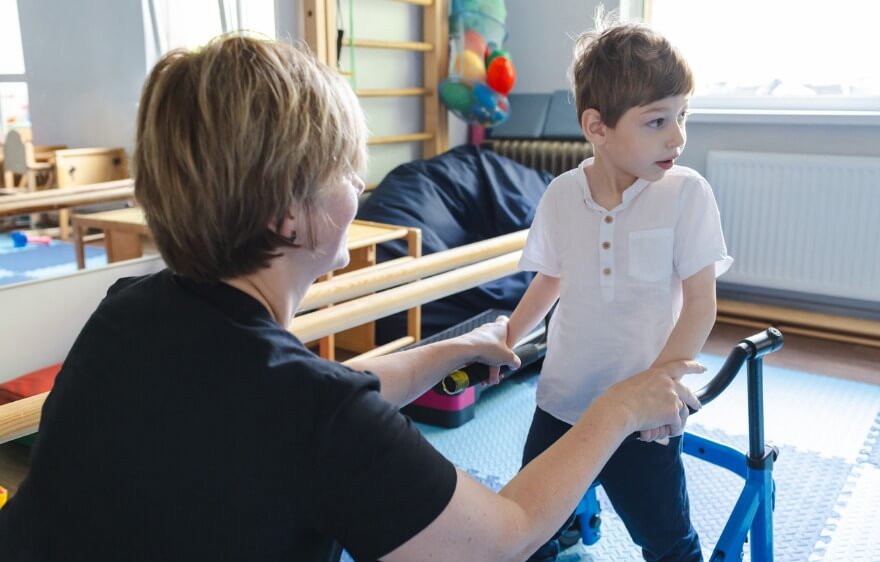I recently came across a post in a homeschooling forum in which a mama of a little guy with Asperger syndrome was looking for ideas to support his learning at home. I have always admired any parent who has the courage to open up and ask for help, so, first and foremost, kudos to the original poster. She sounds like a seasoned mama, so all of this may be of no use to her, but her post (and its responses) got me thinking that this is probably an issue that many families with kids with ASD face at one point or another, regardless of where they are receiving their academic instruction.
5 Tips for Teaching Children with High-Functioning Autism
Teaching students “on the spectrum” always presents unique challenges, regardless of how many letters you have after your name. However, there are some things that can make your life a little easier and help you get down to the business of learning.
Here are five quick tips that SLPs often use when trying to help kids get down to the business of learning:
1. Prioritize Learning Targets
Look at the skill you’re trying to teach and ask yourself a few questions. Do they really need to learn this? Am I willing to go to the mat to teach this? If they don’t learn this right now, what will happen? What is the big picture for this skill? So, for instance, you might be able to let go of something like memorizing the Emperors of Rome because really, I’d wager there are quite a few successful people in the world who can’t name more than two. Identifying numerals, however, you can’t let go because it’s pretty hard to be an independent adult if you can’t recognize numbers.
2. Follow Their Lead
This is one of the central tenets of child-centered intervention, and it applies to learning academics as well. I often equate this idea to the difference between swimming against the current and going with the flow…it is always easier to go with the flow, yes? So if your child’s flow is Legos, go with it. Use Legos to teach those number concepts you just determined that he must learn — write the numbers on the Legos with a Sharpie, write or convert story problems so that they involve Legos, look at the instruction booklet and identify the numbers on each page, make stacks of Legos to correlate with written numbers, heck! You could even try to make the numbers out of Legos. You get the picture. Use your child’s natural interests as the bait to hook them into the concept you’re trying to teach.
3. Use A Tangible Reinforcement System
Understanding abstract ideas like, “You have to learn this because you’ll need it when you’re a grown-up!” and “You can play after you finish your work!” is difficult for all types of students, regardless of whether or not they have an identified disability. However, these concepts can be even more difficult for kids on the spectrum, as thinking in the abstract is often particularly challenging for them. Setting up a tangible reward system helps bring these concepts out of the shadows and into the concrete real world. There are about a gazillion different ways to set one of these up (a million of which are on Pinterest), so find one that makes sense for your family and go with it. I’ve even included a link here for one you can buy, all ready to go, directly from Amazon. The most important thing is that there is some physical representation of task completion that is then rewarded with something your child chooses. Personally, I will work for BBQ chips and/or pedicures, but your kiddo might be into something different 😉
4. Get Visual
If there is one thing we know about students with ASD, it is that they usually benefit tremendously from visual supports for whatever they’re doing. This is well supported in the literature as best practice and with good reason — visuals make things more concrete and easier to understand if you’re the sort who “thinks in pictures,” as Temple Grandin so famously has said. Using tools like visual calendars (or planners for older students), first-then strips, pictures of behavior expectations, and pictures to teach routines, you can say less and do more. Again, the web is chock-full of templates and examples to help you get started. Using visuals throughout your day can help you avoid the heartwrenching (and frustrating) total communication meltdowns that can completely derail your plans to teach those math concepts (remember those?).
5. Get Physical
Another thing we know about most kiddos on the spectrum is that they often have sensory needs that, when unmet, can get in the way of doing anything even remotely productive. An occupational therapist (OT) can help identify your child’s specific sensory needs and develop a “sensory diet” that you can integrate into your learning day. Even if you don’t have access to an OT, you can probably easily identify the physical things your child loves to do and use them to help them meet their learning targets. If they love to hop around, stick those numbers you’re trying to teach to the floor and have Junior jump to each one. Do some chocolate chip math(!) and then have them mix them into cookie batter by hand. Bury their numbers (or math facts) in a bin of rice. Or simply set up your schedule so your child has a 5-minute big-hug-deep-squeeze-cuddle break once an hour. Again, it doesn’t matter how you do it, but getting moving can make a big difference in helping folks with ASD narrow their focus.
So, there you go — five quick (ish) tricks from the SLP tool belt that you can use in your own home to support your child’s learning. Please don’t hesitate to reach out with any questions, concerns, or comments. Happy schooling!
Schedule Your Child’s Care Assessment Today
At Care Options for Kids, we understand the unique challenges of caring for a child with health conditions. Our dedicated team of pediatric home health nurses is here to support your family with compassionate, expert care tailored to your child’s needs. Contact us today to schedule an assessment and learn how we can help you navigate this journey with confidence and care.
Click here to start your journey to better care.





